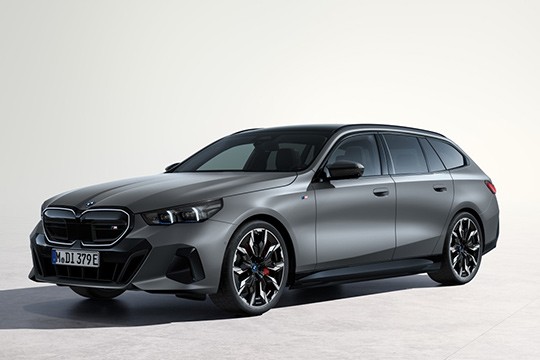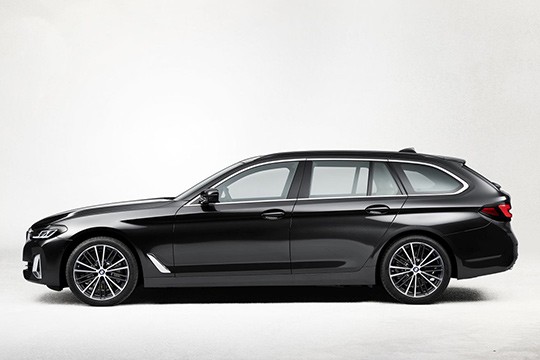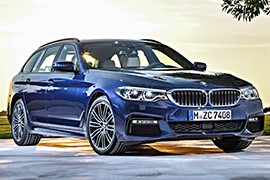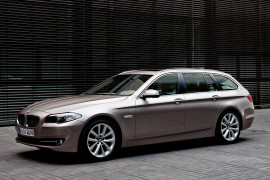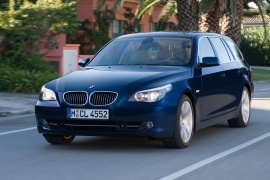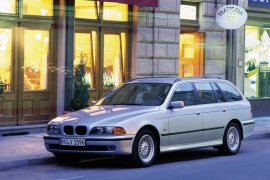BMW 5 Series Touring Models/Series Timeline, Specifications & Photos
First production year: 1992
Engines: Mild hybrid diesel, Mild hybrid, Diesel, Gasoline
Body style: Wagon (station wagon, estate, combi, touring)
In early 2024, BMW completed the range of the eighth generation of the 5 Series with the introduction of the station wagon version, traditionally named Touring by the German automaker.
BMW introduced the first generation of the 5 Series in 1972, but it wasn’t until 1992 that it started offering it as a station wagon. Customers loved it because it came with innovative ideas, such as the opening rear window for the tailgate. Moreover, those who wanted to go fast could get them with an M treatment, if not for all generations, at least for some of them. Come 2023, the German automaker introduced the eighth generation of the 5 Series, and in the same year, it announced the release of the Touring version. Still, that didn’t happen until early 2024 when BMW pulled the wraps off the new G61 5 Series.
From the front, the 5 Series Touring was available with the same options as its sedan sibling. While the base version featured shiny trims around the kidney grille, customers could have that with dark accents or completely dark and a light strip to surround it. The standard LED headlights with an option for laser ones were also included in the package. For the lower bumper, BMW offered a choice of two M packets with black accents and a more or less aggressive stance.
But the biggest surprise was seen on the car’s profile. While the previous generations of the 5 Series Touring were usually slightly longer than their sedan siblings, the 2024 version had the same length as its four-door brother. Another significant design change was for the back of the car. BMW noticed that its buyers didn’t really load their vehicles to the top, so they didn’t actually need a flat, vertical tailgate. As a result, it installed a raked-forward one, which made the car look like a shooting brake. The gasoline and diesel-powered versions of the 5 Series Touring came fitted as standard with 18-inch light alloy wheels, while the plug-in hybrid and the all-electric version sat on 19-inch ones. As an option, the automaker offered other sets of wheels up to 21 inches in size.
Inside, customers were greeted by a wide curved display mounted on top of the dashboard. There were, actually, two screens: one for the instrument cluster and the other for the infotainment system. The latter also featured touch capabilities and ran on BMW’s iDrive 8.5 OS. Like its sedan sibling, it featured eye-activated turn signals for specific markets and a plethora of safety systems. But unlike the sedan, it featured a larger trunk space. With the rear seats up, it provided up to 570 liters (20.1 cu-ft.) of space, while with the rear bench seat folded, it reached a massive 1,700 liters (60 cu-ft.). Surprisingly, these values were nearly identical to what the previous generation of the 5 Series Touring provided.
Under the hood, BMW installed a range of gasoline and turbo diesel engines featuring mild-hybrid technology. In addition, the 5 Series Touring was also available as a PHEV with rear and all-wheel drive systems. An adaptive pneumatic suspension with self-leveling was also offered.
Just three years after it introduced the 5 Series Touring in February 2017, BMW introduced a refreshed version for the 2020 model year, bringing significant visual enhancements to the vehicle, among other upgrades to the interior and the drivetrain.
The seventh generation of the 5 Series, the G30/G31 lineup, was a massive success for the German automaker, and it tried to continue the winning streak with an enhanced version of it. Unfortunately, the 2020 pandemic that plagued the world, followed by the microchip crisis, hindered the car manufacturer’s intentions. Still, the model’s refresh was already planned, and BMW didn’t want to back down. As a result, the Life Cycle Impulse of the G30/G31 broke covers in May 2020.
One of the most significant upgrades to the car was noticed at the front, where BMW introduced new, slimmer LED headlights. These featured L-shaped daytime running lights, further emphasizing the car’s width. In addition, the kidney grille was slightly broader, creating the illusion of an even lower front fascia. The bumper was also replaced, and besides the standard one featuring a large lower air intake, the automaker also offered an M-package to the 2020 5 Series Touring that sported taller side scoops.
The car shared its body panels with its sedan sibling from its profile up to the B-pillars. Behind those was a completely different vehicle, sporting redesigned rear doors and a longer roof, which extended towards the back of the car, up to the rear axle. In addition, the car manufacturer placed a third row of windows between the C- and D-pillars. At the back, the raked-forward tailgate included the classic independently open rear window, which eased the loading and unloading of smaller items into the trunk.
The cabin was also enhanced, and the automaker provided an option for a 12.3-inch display fronting the driver for the instrument panel. On the other hand, base versions featured analog dials with a lower LCD for additional information provided by the car’s onboard computer. Atop the center stack, the 10.25-inch touchscreen also offered new functions and an updated iDrive infotainment system that allowed Apple CarPlay and Android Auto connectivity. In the back, the split-folding bench seat provided enough room for three adults and could enlarge the trunk space from a decent 570 liters (20.1 cu-ft) to 1,700 liters (60 cu-ft), smaller for the hybrid versions due to the battery pack. All four seats were provided with heating functions, while those at the front were also provided with ventilation and massaging.
Under the hood, the automaker installed a choice of diesel, gasoline, and plug-in hybrid systems. The 530e iPerformance gained more muscles and slushed the 0 to 62 mph (0-100 kph) time to an under-six-second time. In addition, a 545e iPerformance plug-in hybrid produced almost 400 ponies, which was a thrill for those looking for a family station wagon able to keep up with some sports cars from that era, thanks to its sub-five seconds acceleration time from naught to a hundred kilometers per hour (0-62 mph).
BMW launched the station wagon version of the 5 Series seventh generation in February 2017, just a month after it released its sedan sibling at the North American International Auto Show.
When the German automaker introduced the 5 Series nameplate in its inventory in 1972, it didn’t offer it with a station wagon version. BMW introduced this family-oriented version only two decades later, for the third generation of this moniker. The car enjoyed great success, and thanks to a few M-powered versions, customers have started to love it. Then, in 2017, the German car manufacturer launched the G30 5 Series (sedan) and the G31 (estate), which was traditionally named Touring. It continued the same design language introduced by the previous F10/F11 generation of the 5 Series. As a result, the car could be considered more of an evolution rather than a revolution. Moreover, it carried over some of the engines and other underpinnings. BMW built the car based on the same CLAR platform used by the 7 Series and the Rolls-Royce Ghost.
One of the most significant technical upgrades to the car was noticed at the front, where BMW installed standard LED headlights across the range. The bi-xenon headlamps were no longer available. In addition, these new units were slimmer and featured sharper lines, creating a sportier look for the vehicle. Depending on the options, the kidney grille was available either with a chromed surrounding or with black trims. BMW offered the 5 Series with a standard bumper that featured slim LED fog lamps and a broad air intake. In addition, it included an M-package on the options list. This enhanced the front look of the vehicle with broader side scoops on the lower bumper.
From its profile, the G31 continued BMW’s idea of creating a sporty-looking estate, even though it meant that it had to diminish the trunk’s space. Up to the B-pillar, the 2017 5 Series Touring shared its components with its G30 sedan sibling. But the extended roof above the rear passengers, up to the trunk compartment, differentiated these two brothers. Furthermore, it added a third row of windows between the rear doors and the D-pillars. Finally, at the back, the raked-forward tailgate featured an independently open rear window. Customers could easily open it to store smaller items in the trunk.
Inside, BMW installed a dashboard that carried over a few ideas from its smaller brother, the 3 Series. It featured a 10.25-inch touchscreen atop the center stack, powered by a new iDrive infotainment system. This new unit introduced the gesture-control system, which allowed customers to change music and radio stations, increase or decrease volume, and perform a few other actions just by waving their hands in front of the screen. In the back, the automaker installed a split-folding (40/20/40) bench seat where three passengers could sit. When the rear seatback was completely folded down, the trunk space increased from 570 liters (20.1 cu-ft) to 1,700 liters (60 cu-ft). As an option, customers could order the G31 with a two-piece panoramic glass roof, which could open. This feature was unavailable on the sedan version of the 5 Series.
Under the hood, BMW installed a wide choice of turbodiesel, gasoline, and hybrid drivetrains. These were paired with an eight-speed automatic transmission, which was enhanced over the one installed on the previous 5 Series. Furthermore, power went to the rear or all corners, depending on the grade and options.
BMW refreshed the entire lineup of the 5 Series’ sixth-generation in 2013, preparing it for the Euro 6 emission standards that were due to come into force in September 2014, and beside the sedan, it also improved the estate version, traditionally named Touring.
The German automaker didn’t come up with new engines at the model’s refresh in 2013, waiting for another year until it replaced the formerly used N-series powerplants with the B-series ones. But still, there were also other significant changes and upgrades that the automaker made to the successful 5 Series. Moreover, it kept its promise to provide customers with a sporty-looking station wagon fitted with enough amenities inside to make buyers feel comfortable and safe at all times. In addition, the introduction of a new infotainment system helped BMW maintain its sales figures high.
There were subtle changes on the car’s exterior, but a keen eye for detail would still notice differences. BMW installed standard bi-xenon headlamps for the entire lineup, with an option for Adaptive LED headlights. In addition, the lower bumper was slightly redesigned, and vehicles fitted with fog lamps had them round-shaped instead of triangular as on the pre-facelifted version. Since BMW didn’t offer the 5 Series F11 (the estate version) with an M-version, like on the previous generation, it still provided an M package that included a revised front bumper with larger side scoops and a chin-spoiler.
The car’s profile looked very much like the non-facelifted version, but the automaker installed new door mirrors featuring integrated LED turn signals. Furthermore, vehicles fitted with the M package sported lowered and aerodynamically profiled side sills that made the 2013 5 Series Touring look sportier. That sensation was amplified by the raked-forward tailgate fitted with the traditional independent opening for the rear window that allowed customers to load and unload smaller items more easily.
Inside, the 5 Series Touring LCI was available with a long list of options that helped it differentiate more from its non-facelifted sibling. BMW provided a new infotainment unit named NBT, which allowed customers to draw letters on the round iDrive controller knob placed on the center stack. They could use that feature to select new addresses or find persons in the phonebook. Fronting the driver was a classic four-dial instrument cluster with a color LCD at the lower half of the panel. Furthermore, a 10.25-inch TFT with configurable layouts was available. In the back, the 5 Series Touring featured a split-folding bench seat (40/20/40), which enlarged the trunk space from 560 liters (19.8 cu-ft) to 1,670 liters (59 cu-ft). Unlike its sedan sibling, the F11 was fitted as standard with adaptive rear suspension that kept the car level regardless of the load in the trunk. Furthermore, the tailgate featured a soft-close function, which was standard across the range.
Under the hood, the automaker installed a wide choice of turbodiesel and gasoline engines paired with a six-speed manual or an eight-speed automatic. Depending on the powerplant version and options, the 2013 5 Series Touring came with either rear or all-wheel drive systems. Those who were looking for more performance for this sporty-looking station wagon could enjoy the upgraded 4.4-liter twin-turbocharged V8 available for the 550i, which produced 450 PS (444 hp). The B-family engines for the inline-four and inline-six replaced the N-family engines later on and produced slightly more power than their predecessors.
BMW 5 Series Touring (F11) LCI 518d 6MT RWD (143 HP)
BMW 5 Series Touring (F11) LCI 518d 6MT RWD (150 HP)
BMW 5 Series Touring (F11) LCI 518d 8AT RWD (143 HP)
BMW 5 Series Touring (F11) LCI 518d 8AT RWD (150 HP)
BMW 5 Series Touring (F11) LCI 520d 6MT RWD (184 HP)
BMW 5 Series Touring (F11) LCI 520d 6MT RWD (190 HP)
BMW 5 Series Touring (F11) LCI 520d 8AT RWD (184 HP)
BMW 5 Series Touring (F11) LCI 520d 8AT RWD (190 HP)
BMW 5 Series Touring (F11) LCI 520d EfficientDynamics RWD 6MT (184 HP)
BMW 5 Series Touring (F11) LCI 520d xDrive 8AT AWD (190 HP)
BMW 5 Series Touring (F11) LCI 525d 6MT RWD (218 HP)
BMW 5 Series Touring (F11) LCI 525d 8AT RWD (218 HP)
BMW 5 Series Touring (F11) LCI 525d xDrive 8AT AWD (218 HP)
BMW 5 Series Touring (F11) LCI 530d 6MT RWD (258 HP)
BMW 5 Series Touring (F11) LCI 530d 8AT RWD (258 HP)
BMW 5 Series Touring (F11) LCI 530d xDrive 8AT AWD (258 HP)
BMW 5 Series Touring (F11) LCI 535d 8AT RWD (313 HP)
BMW 5 Series Touring (F11) LCI 535d xDrive 8AT AWD (313 HP)
BMW 5 Series Touring (F11) LCI M550d xDrive 8AT AWD (381 HP)
BMW 5 Series Touring (F11) LCI 520i 6MT RWD (184 HP)
BMW 5 Series Touring (F11) LCI 520i 8AT RWD (184 HP)
BMW 5 Series Touring (F11) LCI 528i 6MT RWD (245 HP)
BMW 5 Series Touring (F11) LCI 528i 8AT RWD (245 HP)
BMW 5 Series Touring (F11) LCI 528i xDrive 8AT AWD (245 HP)
BMW 5 Series Touring (F11) LCI 535i 6MT RWD (306 HP)
BMW 5 Series Touring (F11) LCI 535i 8AT RWD (306 HP)
BMW introduced the station wagon version of the sixth generation of the 5 Series 2010, expanding the model’s lineup with a vehicle aimed at families.
In September 2010, at the Paris Motor Show, the German automaker unveiled the estate version of the 5 Series, which traditionally received the Touring nameplate. While it didn’t have the largest trunk space in its segment, it impressed with functionality and sportiness. Furthermore, it was available with the latest technologies BMW had in its parts bin and improved the lives of its customers. The automaker said that it could make its trunk larger, but it didn’t want to do that to not spoil the car’s overall look. In addition, dropping some punchy engines under its hood and adding an M-Package on the options list made its buyers forget that this generation of the 5 Series didn’t come with a proper M engine, like its predecessor, the E60.
At the front, the automaker installed the same swept-back headlights as those from the F10 5 Series Sedan. It featured a black kidney grille with chromed trim surrounding it. Lower, on the bumper, the car manufacturer placed an apron with a broad air intake that helped cool the engine. The available fog lamps were installed on the outer side, sporting a triangular shape.
From its profile, the smooth lines of the bodywork were identical to those from the regular 5 Series. Differences started to appear after the B-post. The F11 5 Series Touring featured a longer roof than its sibling, extended above the rear axle. There, the automaker installed a raked-forward tailgate, creating a dynamic look for the premium executive estate. Unlike its sedan sibling, the Touring was available with a panoramic glass roof that could open. Furthermore, the tailgate featured an independent opening rear window, which eased the loading and unloading of small items from the trunk.
Inside, the elegant cabin and dashboard reminded customers that they were in a premium vehicle. Atop the center stack, in an individual cluster, the automaker placed a seven-inch display for the base version, while a 10.2-inch LCD was offered as an option. It was powered by the iDrive 7 system that the driver or their side passenger could control via the rotary dial placed on the center console. In the back, the split-folding (40/20/40) bench seat was wide enough to accommodate up to three passengers. However, the legroom for the one seated in the middle was limited. With the seatback folded, the trunk reached up to 1,670 liters (60 cu-ft.) of space. Unlike its sedan sibling, the Touring came fitted as standard with adaptive rear dampers, which kept the car level regardless of the weight loaded in the back.
Under its hood, the 2010 5 Series Touring came with a choice of diesel and gasoline engines. Depending on the trim and options, these could be paired with either a six-speed manual or an eight-speed automatic. In addition, depending on the country, all versions were available with an all-wheel drive system.
BMW 5 Series Touring (F11) 520d 6MT RWD (184 HP)
BMW 5 Series Touring (F11) 520d 8AT RWD (184 HP)
BMW 5 Series Touring (F11) 520d EfficientDynamics 6MT RWD (184 HP)
BMW 5 Series Touring (F11) 525d 6MT RWD (204 HP)
BMW 5 Series Touring (F11) 525d 6MT RWD (218 HP)
BMW 5 Series Touring (F11) 525d 8AT RWD (218 HP)
BMW 5 Series Touring (F11) 525d xDrive 8AT AWD (218 HP)
BMW 5 Series Touring (F11) 530d 6MT RWD (245 HP)
BMW 5 Series Touring (F11) 530d 6MT RWD (258 HP)
BMW 5 Series Touring (F11) 530d 8AT RWD (245 HP)
BMW 5 Series Touring (F11) 530d 8AT RWD (258 HP)
BMW 5 Series Touring (F11) 530d xDrive 8AT RWD (258 HP)
BMW 5 Series Touring (F11) 535d 8AT RWD (300 HP)
BMW 5 Series Touring (F11) 520i 6MT RWD (184 HP)
BMW 5 Series Touring (F11) 520i 8AT RWD (184 HP)
BMW 5 Series Touring (F11) 523i 6MT RWD (204 HP)
BMW 5 Series Touring (F11) 523i 8AT RWD (204 HP)
BMW 5 Series Touring (F11) 528i 6MT RWD (245 HP)
BMW 5 Series Touring (F11) 528i 8AT RWD (245 HP)
BMW 5 Series Touring (F11) 528i xDrive 8AT AWD (245 HP)
BMW 5 Series Touring (F11) 535i 6MT RWD (306 HP)
BMW 5 Series Touring (F11) 535i 8AT RWD (306 HP)
While BMW launched the 5 Series Touring in 2004, a year after unveiling the 5 Series Sedan, it launched both versions simultaneously when it introduced the facelifted version of the car’s fifth generation.
Three years after unveiling the fifth-generation long-roof 5 Series, the automaker rushed the refreshed version. Sales were low, but the German automaker had to keep that family-oriented vehicle for its customers. While the car’s design still polarized customers, BMW didn’t want to change it. As a result, there were just minor changes on the outside, while the interior and the drivetrain underwent significant upgrades.
There were just some subtle details on the front fascia of the 2007 5 Series Touring. But still, a keen eye for detail could notice the clear lenses of the headlights and the redesigned turn signal lamps. These were no longer light-amber but clear with orange bulbs. As a result, the car’s front looked sharper. BMW also redesigned the car’s lower side of the bumper. It incorporated a broad air intake adorned by a mesh grille flanked by new scoops for the fog lamps. Furthermore, the upside-down center piece that adorned the non-facelifted version of the car was deleted.
From its profile, the updates were even more subtle. But still, the automaker installed new light alloy wheels. At the same time, the turn signal lamps placed on the front bumpers looked identical to the ones provided on the 2004 model year 5 Series Touring. Out back, the automaker placed new lenses over the taillights that flanked the tailgate’s wide opening.
Inside, BMW introduced new trims and upholsteries for the 2007 5 Series Touring. It also created a new design for the center console and the automatic transmission gear selector. While the 2004 model year sported a linear design, for the LCI version, it was a joystick. Its shape was inspired by a set of golf clubs and was featured for the first time on the X5 SUV. Another important upgrade was for the iDrive infotainment system. It was easier to use, and customers started to like it. As expected, the center-mounted screen atop the center stack was too far to be easily reached by the driver, so BMW didn’t install a touchscreen. The system could be controlled via a rotary dial placed between the front bucket seats, which was easy for both front occupants to access. In the back, there was plenty of headroom for three passengers. Surprisingly, BMW found a way to narrow the transmission tunnel so that occupant who sat in the middle could rest their feet left and right. The split-folding bench seat allowed customers to increase the luggage space from a decent 500 liters (17.7 cu-ft) to a respectable 1,650 liters (58.3 cu-ft).
Along with the facelifted version of the car, BMW refreshed almost the entire engine lineup. While some of them were already refreshed in 2005, others were introduced only in 2007. The automaker had to do that since two years before the facelift, Europe switched to the Euro 4 emission standards, and in 2009, there were tougher norms to comply with, namely the Euro 5. As a result, the car manufacturer ditched all the M-code engines from its lineup and replaced them with the newer N-Series. Like its predecessor, it was available with a wide choice of gasoline and turbodiesel engines paired with six-speed manual or automatic gearboxes, with rear- or all-wheel drive versions.
BMW 5 Series Touring (E61) 520d 6AT RWD (163 HP)
BMW 5 Series Touring (E61) 520d 6AT RWD (177 HP)
BMW 5 Series Touring (E61) 520d 6MT RWD (163 HP)
BMW 5 Series Touring (E61) 520d 6MT RWD (177 HP)
BMW 5 Series Touring (E61) 525d 6AT RWD (197 HP)
BMW 5 Series Touring (E61) 525d 6MT RWD (197 HP)
BMW 5 Series Touring (E61) 525d xDrive 6AT AWD (197 HP)
BMW 5 Series Touring (E61) 525d xDrive 6MT AWD (197 HP)
BMW 5 Series Touring (E61) 530d 6AT RWD (235 HP)
BMW 5 Series Touring (E61) 530d 6MT RWD (235 HP)
BMW 5 Series Touring (E61) 530d xDrive 6AT AWD (235 HP)
BMW 5 Series Touring (E61) 520i 6AT RWD (163 HP)
BMW 5 Series Touring (E61) 520i 6AT RWD (170 HP)
BMW 5 Series Touring (E61) 520i 6MT RWD (163 HP)
BMW 5 Series Touring (E61) 520i 6MT RWD (170 HP)
BMW 5 Series Touring (E61) 523i 6AT RWD (190 HP)
BMW 5 Series Touring (E61) 523i 6MT RWD (190 HP)
BMW 5 Series Touring (E61) 525i 6AT RWD (218 HP)
BMW 5 Series Touring (E61) 525i 6MT RWD (218 HP)
BMW 5 Series Touring (E61) 525i xDrive 6AT AWD (218 HP)
BMW 5 Series Touring (E61) 525i xDrive 6MT AWD (218 HP)
BMW 5 Series Touring (E61) 530i 6AT RWD (272 HP)
BMW 5 Series Touring (E61) 530i 6MT RWD (272 HP)
BMW 5 Series Touring (E61) 530i xDrive 6AT AWD (272 HP)
BMW 5 Series Touring (E61) 530i xDrive 6MT AWD (272 HP)
One year after the introduction of the 5 Series E60, BMW introduced the station version, which traditionally wore the Touring moniker.
In 2004, BMW finally came with the Touring version of the 5 Series E60. Unlike its predecessor, the E39, the new vehicle didn’t have the same factory coding number. Instead, it was called the E61. Other than that, it was the same vehicle with the same underpinnings and the same design flaws that affected sales. Moreover, the station wagon was sold in less than 300,000 units, slightly fewer than those from the previous generation, the E39. On the other hand, BMW wasn’t known for being a significant station wagon manufacturer. While its sports sedans were selling like hotcakes, these family-oriented vehicles with large trunks were not that much appreciated. But still, the German automaker had to have something to compete against the Mercedes-Benz E-Class and the A6 from Audi.
The car’s front looked unusual compared to any other BMW ever made. Its swept-back headlights resembled a pair of wings, while the circular daytime running lights were called “angel eyes.” On the lower part of the bumper, the automaker installed an apron fitted with a broad air intake that sported an upside-down trapezoidal shape, flanked by a pair of scoops for the fog lamps.
Like the previous two generations of the station wagons, the E39 and the E34, the E61 5 Series Touring shared its front parts with its sedan brother. Its aluminum hood and fenders helped the vehicle achieve a better weight distribution. Behind the B-posts, the automaker created a long roof extended behind the C-pillars and behind the rear axle. A raked forward tailgate adorned by a roof spoiler on its upper side ended the vehicle. BMW continued the idea of installing a rear window that could be opened without the rest of the tailgate to ease the loading and unloading of smaller items.
Inside, the double-bubble dashboard design was not everybody’s cup of tea. On the other hand, the one installed atop the center stack served for the iDrive infotainment unit and was easy to see by the side passenger. Furthermore, the system’s controller unit, a rotary dial placed on the center console, allowed both front occupants to select their favorite music or to set the navigation. In the back, a split-folding bench seat allowed customers to increase the trunk space from the usual 500 liters (17.7 cu-ft) to a respectable 1,650 liters (58.3 cu-ft).
Under the hood, the automaker installed a wide range of engines, either gasoline or turbodiesel. Regardless of the option, customers could pair them with a six-speed manual or a six-speed automatic. Power was sent to the rear axle or in all corners for the xDrive versions.
BMW 5 Series Touring (E61) 520d 6AT RWD (163 HP)
BMW 5 Series Touring (E61) 520d 6MT RWD (163 HP)
BMW 5 Series Touring (E61) 525d 6AT RWD (177 HP)
BMW 5 Series Touring (E61) 525d 6MT RWD (177 HP)
BMW 5 Series Touring (E61) 530d 6AT RWD (218 HP)
BMW 5 Series Touring (E61) 530d 6AT RWD (231 HP)
BMW 5 Series Touring (E61) 530d 6MT RWD (218 HP)
BMW 5 Series Touring (E61) 530d 6MT RWD (231 HP)
BMW 5 Series Touring (E61) 530xd 6AT RWD (231 HP)
BMW 5 Series Touring (E61) 523i 6AT RWD (177 HP)
BMW 5 Series Touring (E61) 523i 6MT RWD (177 HP)
BMW 5 Series Touring (E61) 525i 6AT RWD (192 HP)
BMW 5 Series Touring (E61) 525i 6AT RWD (218 HP)
BMW 5 Series Touring (E61) 525i 6MT RWD (192 HP)
BMW 5 Series Touring (E61) 525i 6MT RWD (218 HP)
BMW 5 Series Touring (E61) 525xi 6AT RWD (218 HP)
BMW 5 Series Touring (E61) 525xi 6MT RWD (218 HP)
BMW 5 Series Touring (E61) 530i 6AT RWD (258 HP)
BMW 5 Series Touring (E61) 530i 6MT RWD (258 HP)
BMW 5 Series Touring (E61) 530xi 6AT RWD (258 HP)
BMW 5 Series Touring (E61) 530xi 6MT RWD (258 HP)
BMW 5 Series Touring (E61) 545i 6AT RWD (333 HP)
BMW 5 Series Touring (E61) 545i 6MT RWD (333 HP)
Two years after the introduction of the fourth generation of the 5 Series, BMW also introduced the station wagon, also known as the Touring, in the carmaker’s naming system.
When BMW launched the E39 5 Series in December 1995, it was a big shock for its customers, but in a pleasant way. Even though it sported an unusual-looking front fascia compared to its predecessors, the car ended up being appreciated for what it offered. There was only one thing the vehicle didn’t provide: enough room for the luggage area. Unlike its predecessor, the E34, which was available with a long-roof version, the E39 was not. That problem was solved in 1997 when the automaker finally revealed the second generation of the 5 Series Touring.
At the front, the E39 differed a lot from its predecessors. Unlike them, it featured dual headlamps on each side covered by the same piece of glass and corner-mounted turn signals. The bumper also integrated an aerodynamically profiled apron, which could integrate a set of fog lamps. Furthermore, the well-known kidney grille was integrated into the hood and filled the area between the headlights.
From its profile, the long-roof version of the E39 kept the same body panels as its sedan sibling up to the B-pillars. BMW didn’t want to take shortcuts and provide the car with the same rear doors, so it designed new ones despite being a costlier solution. But just like its brother, it featured pulled-out side sills that protected the rear wheels from air current, thus helping lower the drag. Behind the rear doors, the automaker installed a third row of windows next to the trunk area, while at the back, a raked-forward tailgate emphasized the car’s sporty character. Like the previous generation of the 5 Series Touring, the E39’s rear window could be opened independently from the tailgate, easing the loading and unloading of smaller items.
Inside, BMW created a dashboard that followed the bio-design trends. It featured rounded corners and flowing lines. Fronting the driver was an arched visor above the instrument panel. The fuel level and the temperature gauges flanked the large tachometer and speedometer that were installed in the middle. Below them, on a narrow LCD, customers could see data from the onboard computer. The front bucket seats with bolstered areas were divided by a center console that housed the gear stick and an armrest. As an option, the E39 was available with a mobile phone. In the back, a split-folding bench seat could accommodate up to three passengers. It also allowed customers to expand the trunk space from 410 liters (23 cu-ft) to an impressive 1,652 liters (58.3 cu-ft).
Under the hood, BMW installed a new generation of all-aluminum engines that lowered the car’s overall weight. Furthermore, the E39 was the first production model made by the automaker with fully aluminum suspension elements. Customers could get the E39 5 Series Touring with either gasoline or turbodiesel engines paired with five-speed manual transmissions. A four- or five-speed automatic was also available, depending on the engine version.
BMW 5 Series Touring (E39) 520d 5MT RWD (136 HP)
BMW 5 Series Touring (E39) 525d 5AT RWD (163 HP)
BMW 5 Series Touring (E39) 525d 5MT RWD (163 HP)
BMW 5 Series Touring (E39) 525tds 5AT RWD (143 HP)
BMW 5 Series Touring (E39) 525tds 5MT RWD (143 HP)
BMW 5 Series Touring (E39) 520i 5AT RWD (150 HP)
BMW 5 Series Touring (E39) 520i 5MT RWD (150 HP)
BMW 5 Series Touring (E39) 523i 5AT RWD (170 HP)
BMW 5 Series Touring (E39) 523i 5MT RWD (170 HP)
BMW 5 Series Touring (E39) 528i 5AT RWD (193 HP)
BMW introduced the fourth generation of the 5 Series in late 1987, but it waited until 1991 to unveil the station wagon version, which was available as a 1992 model year.
While it was not BMW’s first station wagon vehicle, it was the first based on the 5 Series, and customers loved it because it was a proper sporty family vehicle able to carry many items in its large trunk. The car also impressed customers with its all-wheel drive system available for the 2.5-liter gasoline engine and its fuel-efficient turbodiesel powerplants. Furthermore, most versions could pass the 200 kph (124 mph) mark. In addition, the 5 Series Touring was available with plenty of comfort features and an impressive list of safety features.
At the front, the car retained the four-headlights styling as a design signature for the front fascia, similar to its E12 and the E28 predecessors. But that was the only visual connection. Its turn-signal lamps were placed on the outer sides of the front fascia. Furthermore, the lower part of the front bumper could integrate the available squared fog lamps. It was a consistent evolution over the previous generations of the 5 Series and followed the design language initiated by the 1986 BMW 7 Series (the E32).
The 1988 5 Series came with a curved body styling, showing saved corners and fewer angular details. It was almost the ‘90s, and the boxy styling of the early ‘80s had already been forgotten. Up to the B-post, the Touring shared its components with its sedan sibling. However, after that, the automaker completely redesigned the vehicle. It extended the roof behind the rear passengers, up to the mid-section of the trunk space. It added a third set of windows next to
Inside, the automaker continued the idea of installing a center stack tilted towards the driver. Furthermore, the new dashboard integrated the trapezoidal-shaped instrument cluster filled with BMW’s classic four-dial layout, with a large tachometer and speedometer flanked by smaller gauges for the fuel level and the coolant temperature. Even though it was a station wagon, the car was available with either fabric or leather upholstery. Between the bolstered front seats, the automaker installed a center console that housed the selector for the automatic transmission or the gear stick. In the back, customers could sit on a split-folding (60/40) bench seat that could expand the trunk space from 420 liters (14.8 cu-ft) to 1,670 liters (59 cu-ft).
Unlike its sedan sibling, the 5 Series Touring came fitted with inline-six or V8 engines. It was also available with turbodiesel powerplants. Unfortunately, the all-wheel drive system was available exclusively for the 2.5-liter gasoline unit. But still, that didn’t stop customers from choosing it instead of other premium station wagons with traction in all corners. For the rest of the range, all vehicles sent their power to the rear wheels via a five- or six-speed manual or a five-speed automatic.
BMW 5 Series Touring (E34) 518i 5MT RWD (113 HP)
BMW 5 Series Touring (E34) 520i 5AT RWD (150 HP)
BMW 5 Series Touring (E34) 520i 5MT RWD (150 HP)
BMW 5 Series Touring (E34) 525i 5AT RWD (192 HP)
BMW 5 Series Touring (E34) 525i 5MT RWD (192 HP)
BMW 5 Series Touring (E34) 530i V8 5AT RWD (218 HP)
